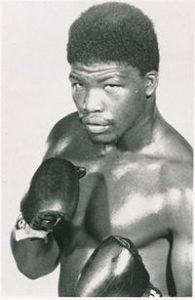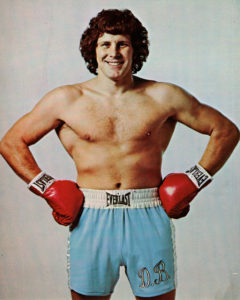The Fighting Machine Revs Up: “Big” John Tate Vs Duane Bobick
 By Kevin “The Voice” Kincade
By Kevin “The Voice” Kincade
While everyone was paying attention to Leon Spinks and his meteoric rise to the World Heavyweight Championship and fall from grace, another 1976 Olympian was slipping into the rankings, under the radar, meticulously climbing the ladder to contendership. Forgotten by most, “Big” John Tate from Marion, Arkansas, the heavyweight representative on the ’76 Olympic Team, came home from Montreal with a Bronze after losing to legendary Cuban Heavyweight, Teofilo Stevenson. While winning any medal is an accomplishment in and of itself, in 1976 his Bronze fell shy of notoriety amidst all the clamor over the five Gold medallions the U.S. Olympic Boxing Team brought home that year; but he was closing in on making his mark in the pro ranks.
“Big” John Tate was just that: “Big”. At 6’ 4” tall and tipping the scales in the neighborhood of 230 Lbs., he was one of the first of the new class of heavyweights. George Foreman, it has been argued, was the first truly big man with outstanding athletic ability to win the World Heavyweight Championship. “Big”John was bigger. Though he did not possess Foreman’s mighty wallop, he was far more mobile and faster handed than Foreman ever dreamt of being.
By February of 1979, Ace Miller and his management team had smoothly positioned him into a clash with another former Bronze Olympic Medalist, Duane Bobick in Market Square Arena in Indianapolis, Indiana. Since his devastating loss to Ken Norton in May of ’77, Bobick had reeled of 10 wins against mediocre opposition and one third round knockout loss to current WBA # 1 contender, Kallie Knoetzee. He needed this win as much, if not more so than Tate did.
Tate had just turned 24 years old the month before and had not even reached his prime yet, while Bobick was in his prime, but on the precipice of falling off the heavyweight map. Almost like the hit Cheap Trick song, which would be topping the charts later on that year, “I Want You to Want Me,” there had been a huge push to get Bobick into the minds and the hearts of boxing fans after he turned pro. It was no small wonder such effort had been invested into pimping Bobick to the public, given his outstanding amateur background and physical abilities; but when Ken Norton squashed him in 58 seconds, some major reevaluating had to be done.
After the loss in Madison Square Garden, he climbed into the ring in Bloomington, Minnesota and faced fellow Minnesotan, tough Scott LeDoux, for the second time, this time stopping him in 8. In his next fight, he knocked out veteran Pedro Agosto in Newark, another confidence  builder. Team Bobick then traveled to South Africa to face 13-2 Kallie Knoetzee. Knoetzee’s two losses had come to undefeated South African Heavyweight hopeful, Gerrie Coetzee and trial horse Reinaldo Raul Gorosito. In a thrilling close fight, Coetzee had decisioned him over ten, which didn’t hurt his ranking. The loss to Gorosito came via disqualification for low blows as Kallie’s aggressiveness got the better of him. As Bobick found out in the third, at 6’1“, 211 lbs., “The Mouth from Boom Street” wasn’t the most skilled boxer; but he carried a punch and, just like that, Bobick’s career was in trouble.
builder. Team Bobick then traveled to South Africa to face 13-2 Kallie Knoetzee. Knoetzee’s two losses had come to undefeated South African Heavyweight hopeful, Gerrie Coetzee and trial horse Reinaldo Raul Gorosito. In a thrilling close fight, Coetzee had decisioned him over ten, which didn’t hurt his ranking. The loss to Gorosito came via disqualification for low blows as Kallie’s aggressiveness got the better of him. As Bobick found out in the third, at 6’1“, 211 lbs., “The Mouth from Boom Street” wasn’t the most skilled boxer; but he carried a punch and, just like that, Bobick’s career was in trouble.
His last eight wins had been hidden from the spotlight in an attempt to rebuild his confidence. He couldn’t afford another devastating loss, not if he garnered any hopes for a championship run. John Tate had been stopped in the first round by Stevenson at the Olympics from Stevenson’s long right hand. So, Duane had a shot, as he also possessed a wicked right. Bobick had actually defeated the Cuban monster in the Pan Am Games before he too fell victim to that same right hand in the third round in the 1972 games. This bout with Tate in Indianapolis could go either way, it just depended on who struck whom first.
Tate had proven himself against puncher and fellow rising heavyweight, Bernado Mercado, handing the then 20-0 Colombian his first defeat in a 2nd Round TKO in Madison Square Garden in only his 13th pro fight. Two months and two fights later he earned a split decision in Houston over tested veteran, Johnny Boudreaux. Tate’s stoic approach in the ring and his attention to detail in following his corner’s instructions had earned him the nickname, “The Fighting Machine”. He kept his guard tight and in good position, he mixed his punches up well in combination from body to head, and he’d shown good stamina and movement, when needed. By all indications, he was ready for a step up in competition and a drive towards the title. This fight with the 28 year old Bobick, who was a known puncher with a vulnerable defense was just what the doctor ordered for both men; but, of course, only one could move forward.
As the fans and the world soon found out, “The Machine” got his motor running early. The result…..was explosive. In less than three minutes of action, Duane Bobick’s name disappeared from people’s lips and the big kid from Arkansas took a huge leap on his journey towards the crown which Muhammad Ali still had in his possession.
“Big” John Tate, “The Fighting Machine,” had arrived…
[si-contact-form form=’2′]

